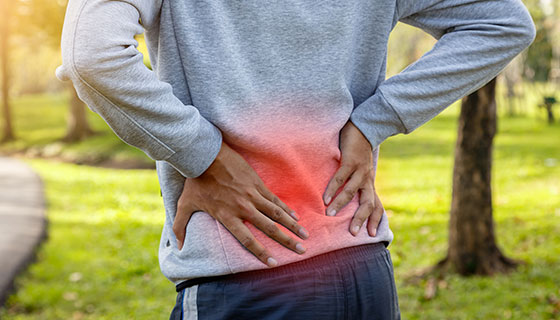Lower Back Pain
Lower back pain is a common issue that most people will experience at some point in their lives. It can range from mild discomfort to intense and debilitating pain, often making it difficult for sufferers to carry out everyday tasks. Lower back pain is usually caused by an injury or strain, although it can be the result of long-term medical conditions such as arthritis or sciatica.
Types of Low Back Pain
Two types of low back pain are often considered. They include:
Mechanical pain. Mechanical pain (axial pain) is one of the principal causes of lower back pain. This pain is mainly experienced by the spinal muscles, ligaments, joints (facet joints, sacroiliac joints), and bones in or around the spine. It occurs mostly in the low back and sometimes the top of the legs.
Radicular pain. A repressed radicular nerve may give rise to mild to intermediate-level pain in the buttocks and or legs. Radicular pain can be triggered by the compressed or inflamed radicular nerve root, which can range from mild to sharp electric burning pain. It is often felt on only one side of the body.
How to Prevent Low Back pain
Build muscle strength and flexibility. Strength and flexibility exercises will help you increase muscle strength, maintain bone density, improve balance and reduce joint pain.
Exercise. Strengthening core muscles and improving balance through regular workouts can reduce the risk of developing chronic back pain. Exercise helps strengthen the muscles of your back which will in turn better support the spine and reduce any pain that may be felt in this area.
Maintain a healthy weight. Maintaining a healthy weight is an important part of living a long and healthy life. In addition to the numerous health benefits, a healthy weight can also help prevent back pain. Many people suffer from lower back pain due to their unhealthy lifestyle choices and by maintaining a healthy weight, it is possible to improve the quality of life through reduced pain and improved mobility.
Avoid movements that twist or strain the back. To use the body properly:
Don't slouch. Maintain a neutral pelvic position. When standing for extended periods, place one foot on a footstool to help relieve some of the tension on the back. Alternate feet. Good posture decreases the tension on the back.
Select a seating option with back support, ample armrests and a swivel base. Keep your pose upright. Keep your knees and hips at the same height as often as possible. A cushy pillow or sponge roll can keep the natural curvature in the back. Tilt and bend at separate times. Perform this exercise every 30 minutes.
Stay light on your feet and avoid heavy lifting if you can do so. If you can't avoid lifting something heavy, bend your knees rather than your back. Always hold heavy objects close to your body. Ask a partner to hold heavy or awkward objects for you if you can.
What are the Stretches & Exercises for Lower Back Pain
Pelvic Tilts
:max_bytes(150000):strip_icc()/Verywell-01-3567179-Pelvic01-035-5989fd580d327a00115d01cc-c954a09ff2ee43fa99c32a1b9e2a03f7.gif)
Do the pelvic tilt to strengthen your abdominal muscles. Lie on your back on the floor with your knees bent. Flatten your back against the floor by tightening your abdominal muscles and bending your pelvis up slightly. Hold for up to 10 seconds. Repeat.
Wall Sits
:max_bytes(150000):strip_icc()/Wall-Sit-shutterstock_724300495-f9556a7acba2437684962d2ad7d8cc0d.jpg)
1
Find a solid, unobstructed wall for a wall sit. Position your back against the wall and spread your legs out about 30 centimeters from the wall. Slide your back down and maintain this hanging position. Hold this position for 10-30 seconds, then release.
Knees to Chest with Head Lift
:max_bytes(150000):strip_icc()/GettyImages-668296954-5e96103d62e04a08a0cfaaa039c2bf26.jpg)
This stretch works your lower and mid-back. Lie on your back, and draw your knees toward your chest. At the same time, raise your head toward your knees and engage in a deep stretch.
Many people live with back discomfort. Stiffness, pain, and limited motion can significantly affect the quality of life. But if you maintain a good weight and stay active, you may be able to avoid back pain. Here at Pro Therapy Supplies, we have the products you need to help you with your back pain. Visit our website or call 770-441-9808 for inquiries.
Start writing here...


